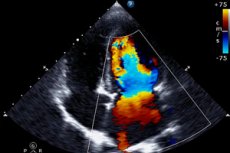Ultrasound diagnostics: new opportunities for non-invasive cancer detection
Last reviewed: 14.06.2024

All iLive content is medically reviewed or fact checked to ensure as much factual accuracy as possible.
We have strict sourcing guidelines and only link to reputable media sites, academic research institutions and, whenever possible, medically peer reviewed studies. Note that the numbers in parentheses ([1], [2], etc.) are clickable links to these studies.
If you feel that any of our content is inaccurate, out-of-date, or otherwise questionable, please select it and press Ctrl + Enter.

Ultrasound imaging offers a valuable and non-invasive way to detect and monitor cancerous tumors. However, invasive and damaging biopsies are usually required to obtain the most important information about cancer, such as cell types and mutations. The research team has developed a way to use ultrasound to extract this genetic information in a gentler way.
At the University of Alberta, a team led by Roger Zemp studied how intense ultrasound can release biological markers of disease, or biomarkers, from cells. These biomarkers, such as miRNA, mRNA, DNA or other genetic mutations, can help identify different types of cancer and inform subsequent therapy. Zemp will present this work on Monday, May 13 at 8:30 a.m. ET as part of a joint meeting of the Acoustical Society of America and the Canadian Acoustical Association, May 13 to 17, at the Shaw Center in downtown Ottawa, Ontario, Canada.
"Ultrasound, at exposure levels higher than those used for imaging, can create tiny pores in cell membranes, which then heal safely. This process is known as sonophoration. The pores formed by sonophoration have previously been used to introduce drugs into cells and tissue. In our case, we are interested in releasing the contents of cells for diagnostics,” explained Roger Zemp from the University of Alberta.
Ultrasound releases biomarkers from cells into the bloodstream, increasing their concentration to a level sufficient for detection. With this method, oncologists can detect cancer and monitor its progression or treatment without the need for painful biopsies. Instead, they can use blood samples, which are easier to obtain and cheaper.
"Ultrasound can increase the levels of these genetic and vesicular biomarkers in blood samples by more than 100-fold," Zemp said. "We have been able to detect panels of tumor-specific mutations and now epigenetic mutations that would not otherwise be detected in blood samples."
Not only has this approach been successful in biomarker discovery, but it is also lower cost than traditional testing methods.
"We also found that we could perform blood tests using ultrasound to look for circulating tumor cells in blood samples with single-cell sensitivity for the price of a COVID test," Zemp said. "This is significantly cheaper than current methods, which cost about $10,000 per test."
The team also demonstrated the potential of using intense ultrasound to liquefy small volumes of tissue to detect biomarkers. Liquefied tissue can be extracted from blood samples or using fine-needle syringes, which is a much more convenient option compared to the damaging method of using a larger needle.
More accessible methods of detecting cancer will not only allow for earlier diagnosis and treatment, but will also enable medical professionals to be more flexible in their approach. They will be able to determine whether certain therapies are working without the risks and costs often associated with repeat biopsies.
"We hope our ultrasound technologies will benefit patients by providing clinicians with a new type of molecular analysis of cells and tissues with minimal discomfort," Zemp said.
